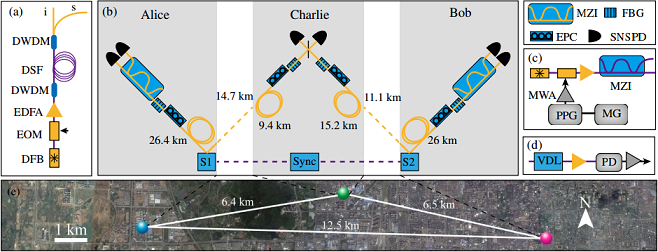
A group of scientists led by Prof. ZHANG Qiang and PAN Jianwei from the University of Science and Technology of China (USTC) have successfully demonstrated entanglement swapping with two independent sources 12.5 km apart using 103 km optical fiber.
Realizing long distance entanglement swapping with independent sources under real-world conditions is important for both future quantum networks and the fundamental study of quantum theory.
However, due to its high susceptibility to environmental effects, demonstration of the principle had previously been achieved over only a few tens of kilometers of underground optical fiber, and there had been no report of implementation using optical fiber longer than 100 km or using suspended optical fiber.
To increase the experimental distance, USTC scientists exploited two independent 1-GHz-clock sequential time-bin entangled photon-pair sources, developed several automatic stability controls, and successfully implemented a field test of entanglement swapping over a 103-km optical fiber link composed of about 77-km of optical fiber inside the lab, 25-km of optical fiber outside the lab but kept underground, and 1-km of optical fiber suspended in the air outside the lab to account for various types of noise mechanisms in the real world.

Figure. Scheme of the entanglement swapping experiment. (Image by ZHANG Qiang)
The team has increased the length of optical fiber from metropolitan distance to inter-city distance. It is worth noting that suspended optical fiber was used in the experiment. The loss and stability of the optical fiber channel in the experiment was enough to match that of typical underground deployed optical fiber more than 100-km in length.
To increase the event rate, the scientists updated the sources to 1-GHz sequential time-bin entangled photon-pair sources. In addition, they improved the polarization and delay compensation system. The work was published in Optica, titled as “Entanglement swapping over 100 km optical fiber with independent entangled photon-pair sources”.
The setup of this experiment provides a promising platform for many fundamental tests in the future. The configuration of the experiment allows the space-like separation between any two measurements of distance as performed in the experiments, and various time-space relations can be achieved by combining both coiled optical fiber and deployed optical fiber.
The results show that realizing entanglement swapping between two cities is technically feasible, even if more suspended fiber is used.
The experiment also verifies the feasibility of such technologies for long distance quantum networks and opens up new possibilities for future applications in more complicated environments.
As Hoi-Kwong Lo, associate editor of Optica, said, “Entanglement swapping over long distances is a crucial ingredient for quantum networks in optical fiber. The paper provides important details about the synchronization of the sources, the stabilization of the optical distance, and polarization.”

86-10-68597521 (day)
86-10-68597289 (night)

52 Sanlihe Rd., Xicheng District,
Beijing, China (100864)

